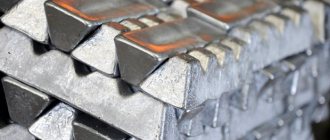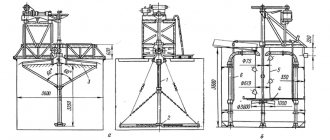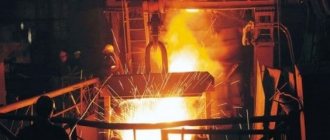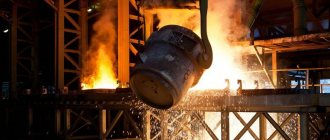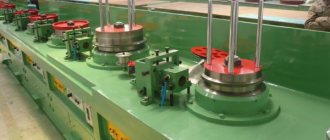Obtaining iron from improvised means in ancient times
Home » Mysteries of the history of the distant past » Obtaining iron from improvised means in ancient times
Mysteries of the history of the distant pastMysteries of the history of the distant past
Bobblehead 02/11/2019 3496
16
in Favoritesin Favoritesfrom Favorites 8
About hardware - in simple and accessible language
Iron production in Rus' has been known since time immemorial. As a result of archaeological excavations in areas adjacent to Novgorod, Vladimir, Yaroslavl, Pskov, Smolensk, Ryazan, Murom, Tula, Kiev, Vyshgorod, Pereyaslavl, Vzhishch, as well as in the area of Lake Ladoga and other places, hundreds of places with the remains of melting pots were discovered , cheese furnaces, so-called “wolf pits” and corresponding production tools of ancient metallurgy. In one of the wolf pits, dug for iron smelting, near the village of Podmokloye in the southern part of the Moscow region coal basin, a coin was found dated 189 of the Muslim era, which corresponds to the beginning of the 9th century of modern chronology. This means that they knew how to smelt iron in Rus' back in those distant, deeply pre-Christian times.
The names of the Russian people literally shout to us about the prevalence of metallurgy throughout the territory of ancient Rus': Kuznetsov, Kovalev, Koval, Kovalenko, Kovalchuk. In terms of prevalence, Russian “metallurgical” surnames, perhaps, compete even with the archetypal English John Smith (who, in fact, is a blacksmith , that is, the same blacksmith).
However, the path of any sword or cannon barrel always began much earlier than the metallurgical forge and, especially, the forge. Any metal is, first of all, a fuel (coal or coke for its smelting), and secondly, a raw material for its production.
Here I must immediately place emphasis. Why is fuel the primary condition, and iron ore itself is so boldly relegated to the background? It's all about the logistics of transporting ore and fuel needed to produce iron in the Middle Ages.
After all, the main, and the highest quality, fuel for the smelting of medieval, high-grade iron was charcoal .
Even now, in the modern enlightened age, the task of obtaining high-quality charcoal is by no means as simple as it seems at first glance.
The highest quality charcoal is obtained only from a very limited number of wood species - from all fairly rare and slow-growing hardwood species (oak, hornbeam, beech) and from the archetypal Russian birch .
Already from coniferous trees - pine or spruce, charcoal turns out to be much more fragile and with a large yield of fines and coal dust, and trying to get good charcoal from soft-leaved aspen or alder is almost impossible - the yield of good quality drops by almost half compared to oak.
If there were not a sufficient number of forests in the area where iron deposits were found, or if the forests in the area were destroyed by previous generations of metallurgists, it was necessary to invent various ersatz substitutes. For example, in Central Asia, despite high-quality iron ore deposits, timber was tight, so instead of charcoal it was necessary to use the following innovative fuel:
If anyone doesn’t understand, this is cow dung. It can be horse, lamb, goat or donkey - it doesn’t play a special role. The dung was kneaded by hand into flat cakes (somehow
), and then laid out to dry in the sun.
It is clear that in such a situation there was no need to talk about the “constancy of the composition” of the fuel, and the flame temperature from the combustion of such “composite fuel” was much lower than that of high-quality charcoal.
Another, much more technologically advanced replacement for charcoal appeared in the world much later. We are, of course, talking about coke , on which all modern ferrous metallurgy is now based.
The history of the “invention” of coke goes back only two hundred years. After all, it was the coke oven battery, in which “coal burned itself out,” that was the first, most powerful salvo of the industrial revolution. It was she, the coke oven battery, and not the oil rig that created the “world of coal and steam” that we now love to remember in books, films and anime about steampunk.
Long before the Industrial Revolution, England had already developed rich deposits of coal, which, however, was used almost exclusively for heating homes. Ore smelting in England was carried out, as in many places in the world, only with charcoal. This was due to an unpleasant fact characteristic of most coals - they contain considerable amounts of phosphorus and sulfur, which are very harmful to the iron produced in the forge.
However, Great Britain is an island. And, ultimately, the growing needs of English metallurgy, based on charcoal, exceeded all the capabilities of English forests. The English Robin Hoods simply had nowhere to hide - the increase in iron smelting reduced almost all the forests of Foggy Albion to nothing. Ultimately, this became a brake on iron production, since smelting required a huge amount of firewood : to process one ton of ore - almost 40 cubic meters of raw wood.
Due to the increasing production of iron, there was a threat of complete destruction of forests. The country was forced to import metal from abroad, mainly from Russia and Sweden. Attempts to use fossil coal for iron smelting were unsuccessful for a long time, for the reason stated above.
Only in 1735, the manufacturer Abraham Derby, after many years of experience, found a way to smelt cast iron using coking coal. It was a victory. But before this victory at the beginning of the 9th century AD there were still more than 900 years left.
So, transporting firewood (or even finished charcoal) to the iron does not work simply because of the logistics of the process - the fuel needs to be 4-5 times the mass of the ore, and even more by volume - at least ten times. It is easier to bring iron to fuel.
There is fuel in Ancient Rus', and in abundance. What about the hardware on the Russian platform?
But there are questions with the hardware. high-quality iron ore on the Russian Plain .
I immediately hear shouts: “What about the Kursk magnetic anomaly? The highest quality magnetic iron ores in the world!”
Yes, some of the highest quality in the world. Opened in 1931. Depth of occurrence - from 200 to 600 meters. The task is clearly not for the technologies that were at the disposal of the ancient Slavs in the 9th century AD. Now everything looks beautiful, but for that time the picture of a modern iron ore mine was like a journey to Alpha Centauri for modern humanity. In theory it is possible, but in practice it is not:
As a result, in the 9th century in Rus' it is necessary to make a choice from something included in this list of all iron ores currently used by humanity:
- magnetic iron ore - more than 70% Fe in the form of magnetite Fe3O4 (example: just the Kursk magnetic anomaly we described) - red iron ore - 55-60% Fe in the form of hematite Fe2O3 (example: again the Kursk magnetic anomaly or the Krivoy Rog basin) - brown iron ore (limonite) - 35-55% Fe in the form of a mixture of ferric iron hydroxides Fe2O3-3H2O and Fe2O3-H2O (example: Kerch deposit ruined by Ukraine). — spar iron ore — up to 40% Fe in the form of carbonate FeCO3 (example: Bakalskoe deposit)
Magnetite and hematite lie deep on the Russian platform; there is no spar iron ore on it at all. What remains is brown iron ore (limonite).
The raw material, to put it mildly, is lousy - just look at the concentration of iron in it, but the funny thing is that it is available almost everywhere . In addition, this “almost everywhere” miraculously turns out to be in close proximity to the then source of high-quality coal fuel - the mighty forests of the Russian Plain.
We are, of course, talking about peat bogs and limonite, which is also often called bog iron .
In addition to bog iron, meadow and lake iron . However, as you will see later, digging for such iron was most profitable in a swamp.
To understand the breadth of prevalence of the actual extraction of this local resource in Rus', it is enough, as in the case of “metallurgical surnames,” to simply open any geographical map and look at the names of Russian, Ukrainian, Belarusian or Lithuanian villages.
And immediately a huge number of toponyms with the words Guta, Buda, Ruda will catch your eye. Here are their meanings:
Guta: glass smelting plant Ore: mining of bog iron Buda: mining of potash from plant ash.
You will find such villages everywhere - in a wide belt in the Polesie swamps - from Brest to Sumy. There were plenty of sources of “swamp ore” in Rus'. “Swamp iron” is generally formed almost everywhere where there is a transition from oxygen-containing soils to an oxygen-free layer (exactly at the junction of these two layers).
In swamps, this boundary is simply located, unlike other types of terrain, very close to the surface , so there iron nodules can be dug literally with a shovel, only removing a thin layer of swamp vegetation.
This is how bog iron looks unpretentious . But it was precisely this that saved Rus'.
The bog iron deposits themselves are classic placers . Placers are usually much smaller deposits than ore bodies, their total volume rarely exceeds tens of thousands of tons (while ore deposits can contain millions and billions of tons of ore), but mining placers is usually much simpler than mining an ore body.
Placers can usually be developed almost with bare hands and with minimal crushing of the rock, since placers usually occur in already destroyed sedimentary rocks.
This is generally a common practice: placers are mined first, then ores.
Moreover, for all metals, minerals or compounds.
By the way, “wooden tin” (which I wrote about in the series about the Bronze Age Catastrophe) is also a placer.
However, it cannot be said that mining bog iron placers was a simple task.
Swamp iron was mined in three main ways.
The first - in the summer, bottom silt was scooped from rafts in swamp lakes and rivers flowing from swamps. The raft was held in one place by a pole (one person), and another person used a bailer to remove silt from the bottom. The advantages of this method are simplicity and low physical stress on workers. Disadvantages - a large amount of useless labor, since not only was waste rock scooped up with bog iron, but in addition, large quantities of water along with silt also had to be lifted up. In addition, it is difficult to use a scoop to remove soil to great depths.
Second way. In winter, in places where the channels froze to the bottom, the ice was first cut down, and then the bottom sediment containing bog iron was also cut down. The advantages of this method: the ability to select a large layer containing bog iron. Disadvantages: it is physically difficult to chisel ice and frozen ground. Extraction is possible only to the freezing depth.
The third method was the most common. On the shore, near channels or marsh lakes, a frame was assembled, as for a well, only in larger sizes, for example, 4 by 4 meters. Then they began to dig out the covering layer of waste rock inside the log house, gradually deepening the log house. Then the rock containing bog iron was also selected. The rolls of logs were added as the log house deepened. The constantly flowing water was periodically bailed out. It was, of course, possible to simply dig without strengthening the walls with logs, but in the event of a very likely collapse of the washed away soil and the workers falling asleep in the hole, it would hardly have been possible to save anyone: people would quickly choke and drown. The advantages of this method: the ability to select the entire layer containing bog iron, and less labor costs compared to the second method. In addition, it was possible, even before the start of mining, to approximately determine the quality of the extracted raw materials (“the local residents also judge the goodness of the ore by the type of trees growing on it; thus, the one found under the birch and aspen trees is considered the best, because the iron from it is softer, and in places where the spruce forest grows, it is tougher and stronger"). Disadvantages: you have to work in water all the time.
In general, ancient Russian miners had a hard time. Now, of course, reenactors all over the world are making field trips and even digging holes in drier and more accessible places, where they can easily mine some swamp ore:
The children of the reenactors are happy. In the 9th century, I think everything was different.
However, to understand the situation in Russia in the 9th-12th centuries, it is necessary to understand the scale of the fishery that was organized by our ancestors on such an abundant resource as swamp placers. After all, if the process of digging up silt in swamps itself did not leave any traces traceable through the centuries, then the subsequent processing of bog iron left traces in the cultural layer, and what kind of ones too!
After all, for the cheese-blowing process, which at that time was used in ancient Russian metallurgy and produced highly ferrous slag, very iron-rich ore was needed. And limonite, as we remember, is a poor ore.
To obtain a good limonite concentrate, it was necessary to pre-enrich the mined ores - both swamp and meadow. Therefore, ancient Russian metallurgists necessarily enriched bog iron ores going into smelting.
The enrichment operation was a very important technological condition for the production of iron in cheese furnaces.
Later studies, through analysis of historical monuments, revealed the following methods of ore enrichment:
1) drying (weathering, within a month); 2) firing; 3) grinding; 4) washing; 5) sifting.
The production of highly concentrated ore could not be limited to just one or two operations, but required systematic processing by all of the above methods. An archaeologically well-known operation is ore roasting.
As you understand, roasting also required high-quality fuel (charcoal), and also in considerable quantities.
During archaeological exploration near the village of Lasuna on the coast of the Gulf of Finland, a heap of burnt ore was discovered in one of the pits. For all ore enrichment operations, very simple equipment is required: for crushing ore - a wooden block and mortar, and for sifting and washing - a wooden sieve (mesh of rods).
The disadvantage of firing bog ore in fires and pits was the incomplete removal of water from it when roasting large pieces and large losses when roasting small pieces.
In modern production, of course, enrichment is much simpler - finely crushed ore is mixed with the same ground coke and fed into a device similar to a large meat grinder. The auger feeds the mixture of ore and coke onto a grid with holes no larger than 8 mm. Squeezing out through the holes, such a homogeneous mixture enters the flame, while the coke burns, melting the ore, and in addition, sulfur is burned out of the ore, thus simultaneously desulfurization of the raw materials occurs.
After all, bog iron, like coal, contains harmful impurities - sulfur and phosphorus. It was, of course, possible to find raw materials containing little phosphorus (well, relatively little - there is always less of it in ore iron than in bog iron). But it was almost impossible to find bog iron, which contains little phosphorus and sulfur. Therefore, in addition to the whole industry of bog iron extraction, an equally large-scale industry of its enrichment arose.
To understand the scope of this action, I will give one example: during excavations in Old Ryazan, traces of “home” cooking of iron in pots in an ordinary furnace were found in 16 out of 19 dwellings of townspeople
Western European traveler Jacob Reitenfels, having visited Muscovy in 1670, wrote that “the country of the Muscovites is a living source of bread and metal.”
So, in a bare place, with nothing under them except poor forest soils with stunted birch trees and peat bogs, our ancestors suddenly discovered a “gold mine” literally under their feet. And even if it was not a vein, but a placer, and not gold, but iron, the situation did not change.
The still emerging country has received its place in the world and a civilizational path that will lead it to the Balaklava guns, to the T-Z4 tank and to the Topol-M ICBM.
Resources. Job. Production. Weapon.
Because having resources, you inevitably come to weapons. Or - someone else comes for your resources.
The Iron Age began in Rus'.
A century—or rather, a millennium—of Russian weapons.
https://seva-riga.livejournal.com/664219.html?thread=83120027
Getting the iron itself.
Swamp ores are much more widespread. They were formed in the sub-Atlantic period, when, during the process of swamping, iron ore settled to the bottom of reservoirs. Throughout the Middle Ages, ferrous metallurgy used bog ores. They even paid duties with them. The production of iron from ore in relatively large quantities became possible after the invention of the cheese furnace. This name appeared after the invention of blowing heated air in blast furnaces. In ancient times, metallurgists supplied raw (cold) air into the forge. At a temperature of 900o, with the help of carbon dioxide, which removes oxygen from iron oxide, iron is reduced from the ore and a dough or shapeless porous piece soaked in slag is obtained - kritsa. To carry out this process, charcoal was needed as a source of carbon dioxide. The kritsa was then forged in order to remove the slag from it. The cheese-making method, sometimes called iron smelting, is uneconomical, but for a long time it remained the only and unchanged method of obtaining ferrous metal.
At first, iron was smelted in ordinary pits, closed at the top, and later they began to build clay furnaces - forges. Crushed ore and coal were loaded into the working space of the forge in layers, all this was set on fire, and air was forced through the nozzle holes with special (leather) bellows. The rock settles into slag at a temperature of 1300-1400o, at which steel is obtained - iron containing from 0.3 to 1.2% carbon. As it cools, it becomes very hard. To obtain cast iron - fusible iron with a carbon content of 1.5-5% - you need a more complex forge design with a large working space. In this case, the melting point of iron was lower, and it partially flowed out of the furnace along with the slag. When it cooled, it became brittle, and at first it was thrown away, but then they learned to use it. To obtain malleable iron from cast iron, you need to remove carbon from it.
The process of iron production is well reflected in the Finno-Ugric epic “Kalevala”.
https://investments.academic.ru/946
I won’t write about the further growth of furnaces for production and their development into blast furnaces. Just personal experience of ignition, in the form of a bag of charcoal and a regular vacuum cleaner. The vacuum cleaner had to be connected via LATR to reduce the power to a minimum (it blows a lot and it’s a pity for the coal).
Super technology in the form of a barrel (screen), a 150x150 forge nest at the bottom and blowing from a vacuum cleaner. The bottom is covered with clay, there is a depression near the nest. Heat shielding with fireclay bricks. I make coal in pits and in a potbelly stove, and soon I’ll learn how to use a frying pan too...
It heats up well for forging right away, but I wanted more. 30 mm of clay and a depression just gave a zone of increased heat (in Japanese forges there is an almost round depression of 200x200 mm). The experiment did not work right away, then orders, then something else, I remade the forge and forgot to check. Another order, out of habit I work with thick stuff on the bottom with small change (I’m used to it not heating enough!), but here I pulled out large pieces, and they were chewed on like worms! White and sparks fly! Beauty!!!! Well, I checked it a couple more times, then I barely put the blanks into use, they were half burnt...
Considering the power of even such a primitive installation, a crucible should work, but it’s a pity for coal...
Oops:
https://mydocx.ru/10-68355.html
Ice mount.
Used in very rare cases. It can be used in pits in winter, in cold continental climates. In these cases, pits are laid in shallow frozen rivers or creeks. Near the laying site, the thickness of the ice is first checked, and then a pit is started in the intended place. On the first day, the pit is passed in such a way that ice 81-0 cm thick remains in the face. After one or several days, depending on the frost, when the ice freezes below the face to a certain depth, the pit is carefully deepened to a small length (0.1 -0.2 m) and again left to freeze. So they reach the bottom of the reservoir and go deeper into the rocks. Similarly, work can be carried out in aquifers. Drilling with freezing should be done very carefully. Holes driven across the river can create a backwater, which will lead to ice breakthrough upstream of the river.
Types of iron ores.
Iron ore varies in the amount of iron it contains. It can be rich, in which it is more than 57%, and poor – from 26%. Low-grade ores are used in industry only after they have been enriched.
By origin, ore is divided into:
- Igneous – ore obtained as a result of high temperatures.
- Exogenous – sediment in sea basins.
- Metamorphogenic - formed as a result of high pressure.
Iron ores are also divided into:
- red iron ore, which is the most common and at the same time the richest ore in iron;
- brown iron ore;
- magnetic;
- spar iron ore;
- titanomagnetite;
- ferruginous quartzite.
They all contain varying amounts of iron (26–70%), harmful impurities in the form of sulfur or phosphorus, and waste rock.
